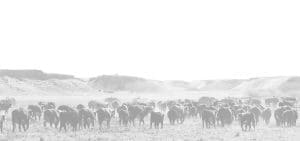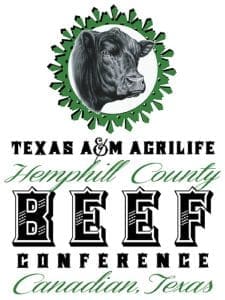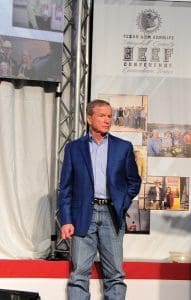
By Larry Stalcup Contributing Editor
Andy Holloway’s booming personality and ability to round up a steadfast local committee and stellar sponsors have made the Hemphill County Beef Conference one of the nation’s most dynamic cattle events. Big-name speakers like Sarah Huckabee, Mike Pompeo and this year’s Willie Robertson present patriotic, entertaining and inspirational topics. And to boost producer profits, experts in beef production and marketing provide insight to help ranchers yield quality calves that are sought by feedyards.
Holloway is a Texas A&M AgriLife Hemphill County Extension agent in Canadian in the northeast Texas Panhandle. He never meets a stranger. He loves to promote his “heart of the prairie” ranching sector, as well as area stocker operations and feedyards. “We do a lot of promotion because we’re so passionate about sharing this information with all cattle producers,” he boasted during the late-April conference.
“We had 708 participants this year and a sold-out trade show. This is great information for ranchers. It provides many networking opportunities to benefit themselves and others.”
For decades, Canadian Feed Yard, east of the picturesque town of about 2,700, has been buying cattle from producers in the Texas and Oklahoma panhandles and other High Plains ranches. “That feedyard has been good for cow-calf people, whether or not they retain ownership of calves through the feeding [period],” Holloway said.
“All feedyards in the Panhandle area are vital to our future. Feeding cattle is how we get our calves harvested and help feed the world. About 28 percent of the nation’s fed beef comes from the Texas Panhandle. That’s a big deal.
“Our conference participants tell us over and over this event helps them add value to their cattle,” he said. “It helps them add to their bottom line. That’s extremely important when input costs are out of the roof.”
Female of the Future Through Heterosis
Among the speakers were those who discussed breed and crossbred herd performance. Tom Brink of the Red Angus Association of America described the benefits of heterosis and what to look for in a cow:
• She should breed early as a heifer, calve early in the calving season and repeat that cycle seven or more times.
• She should also have good feet, udders and a good disposition, and not be too big or too small.
• She should “flesh with relative ease” on various types and qualities of forage.
Brink said heterosis could be improved by using three complementary breeds in a program. “Attempting to maximize heterosis is a great plan,” he said. He added that the cow should be crossbred from a planned mating system, screened carefully as a heifer, produce calves that have adequate weight and marbling potential, and fit into one or more value-added programs.
Brink pointed out a quote from Jason Cleere, Texas A&M University beef cattle specialist: “When deciding on the best strategy for adding heifers, producers need to weigh the advantages and disadvantages of raising or buying replacement females, as well as consider other economic and general management issues specific to their operations.”
Cleere indicates that female development depends on various factors, including current and future market prices, herd size, pastures, facilities and management level, available labor, economics, herd health concerns, cow genetic base in a crossbreeding system, herd quality and purchase replacement alternatives.


Another speaker was CattleFax analyst Troy Applehans. He talked about cattle production, marketing and issues that may impact them in the months and years ahead, including:
• Drought is forecast to subside in 2023, but herd liquidation will continue to drive tighter cattle supplies and beef production for several years.
• Recessionary and inflationary challenges are real, but U.S. beef demand is expected to remain resilient.
• Producing a high-quality, safe, satisfying product should pay dividends.
• Expect higher prices into mid-decade, outpacing input costs and driving improved producer profitability.
Other conference speakers included Don Basse of Ag Resources Co.; Lee Leachman of Leachman Cattle; Josh Worthington of Worthington Angus; Travis Thorne of Capital Farm Credit; Trevor Caviness of Caviness Beef; Hemphill County area producers Adam Issacs and Jason Abraham; AgriLife’s Dan Hale and Ty Lawrence; and Throckmorton, Texas, producer Donnell Brown, who moderated the two-day program.
The 2023 beef conference was dedicated to the late George Clift, who passed away last year. Born and raised in Lexington, Okla., he relocated to the Texas Panhandle where he was a leader in crop and cattle production and feeding, rural real estate handling, and a master at giving back to his beloved Panhandle region.
Holloway said Clift was one of many who provided input into the Hemphill County conference. “We’ve been fortunate to receive tremendous support from producers, feeders and allied industries from across the High Plains,” he said.
“Our conference committee and backing from our local community are also reasons why we have such a large conference here in Canadian. We thank everyone who helped make this event possible.”
For more on the conference and its sponsors, visit https://www.hemphillcotxbeef.com.
PRODUCER OWNED BEEF UPDATE

Dirt is being moved just east of Amarillo for construction of the much-anticipated Producer Owned Beef, LLC (POB) – a $700 million beef processing facility that will have the capacity to process more than 3,000 head per day.
Official groundbreaking for the state-of-the-art packing plant is scheduled for mid-summer, said Monte Cluck, POB Board member of Boerne, Texas, who discussed the POB program during the Hemphill County Beef Conference in April.
The plant is expected to employ 1,600 people at full capacity. Its payroll will likely top $121 million annually. Cluck said POB is scheduled to open in 2026 and hit full capacity in 2027.
A major difference between POB and the four major packers that currently buy about 80 percent of all fed cattle in the U.S. is that it is destined to be 100 percent producer-owned, added Ross Wilson, former Texas Cattle Feeders Association CEO, and now a consultant in the POB program.
POB is being built by Wayne Schmeeckle of Schmeeckle Bros. Construction in Fort Morgan, Colo. “He is among the best in the business,” Wilson said. “He has two packing plants coming online, one of which is Sustainable Beef in North Platte, Neb. “We’re optimistic at where we are in our producer-owned project.”
Cluck is president of Dean Cluck Feedyard, Inc., a fourth-generation crop and cattle operation in Gruver, Texas. He has offices in downtown Amarillo, as does POB. Cluck is determined one day to see a portion of the cattle fed at his family feedyard operations processed by the producer-owned packing plant.
“We’re taking control of what we do,” Cluck told the beef conference participants. “Producers from 12 states are committed to providing cattle to POB – but all cattle must be finished at feedyards in Texas, Oklahoma or New Mexico.”
The producer-owned equation is new to major beef packing, but not livestock. Cluck said about 25 percent of farrow-to-finish pork is now processed by producer-owned facilities. “They wanted to gain more margins available in the pork value chain,” he said. “That’s what we’re doing with POB.”
There are skeptics of the project. It’s a huge financial task. The minimum investment by cattle producers is about $230,000. Cattle supplies are expected to be tight in the next few years.
“We realize it is a major investment and there will be competition for cattle from the major packers,” Cluck said. “But we have much of the equity and investment in place. Higher interest rates might have pressured financing, but we still have support from small and large local banks and other lenders.”
Today’s lower cow herd numbers are expected to begin cycling upward within two years. “We think our timing is perfect,” Cluck explained. “We feel we can reach full capacity in 2027 when the nation’s cow herd is expected to be rebuilt. Since this is an LLC, producer investors in the plant will be able to earn returns on their investments as well as have an additional market for their cattle.
“Failure is not an option,” he added. “We have support from producers from Hawaii to Florida and Canada to El Paso. Cattle committed and bought from every state will be fed in Texas, Oklahoma or New Mexico feedyards, which will benefit our regional economy.
“And at the end of the day, we’re going to have a new state-of-the-art plant.”





